

Programmez en Objective-C ! Atomic Spin. Laying out the user interface of a mobile app (or any app for that matter) is not a simple process.
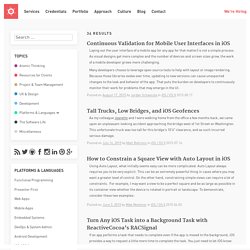
As visual designs get more complex and the number of devices and screen sizes grow, the work of a mobile developer grows more challenging. Many developers choose to leverage open source tools to help with layout or image rendering. Because those libraries evolve over time, updating to new versions can cause unexpected changes to the look and behavior of the app. That puts the burden on developers to continuously monitor their work for problems that may emerge in the UI. Read more on Continuous Validation for Mobile User Interfaces in iOS… Evaluating Expressions in iOS with Objective-C and Swift.
Recently, I have been researching ways to evaluate string expressions such as "(1 + 3) * 5 / 2" in iOS.
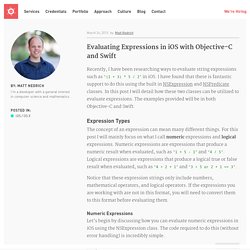
Easier Multiple Storyboards in iOS with Custom Segues. One of our latest iOS projects has quite a few view controllers.
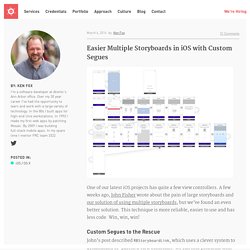
A few weeks ago, John Fisher wrote about the pain of large storyboards and our solution of using multiple storyboards, but we’ve found an even better solution. Custom delegates, the Apple way. When you get into Mac or iOS development, you'll soon be confronted with delegates.
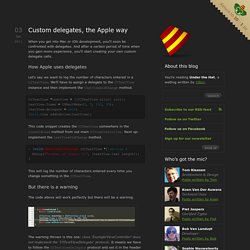
And after a certain period of time when you gain more experience, you'll start creating your own custom delegate calls. How Apple uses delegates Let's say we want to log the number of characters entered in a UITextView. Objective c advanced tutorial. Passbook for Developers. iOS Development Tutorials. Standford ios.
Huxtek ios. WWDC 2014 Session Videos. JavaScript for AutomationSession 306Play Automation in OS X has always been about power and choice.

Scriptable applications, including Pages, Keynote, Numbers, and the Finder, can already be automated using a variety of languages, including AppleScript, Objective-C, Perl, Python, and Ruby. With OS X Yosemite, application scripting support has been added to another popular language, JavaScript. JavaScript for Automation (JXA) extends the standard JavaScript environment provided by the JavaScriptCore framework with support for querying and controlling all of the scriptable applications running in OS X.
JXA scripts are supported at all layers of the system and can be invoked from the command-line, from the system-wide Script Menu, and can even be distributed as code-signed applications. Download: HD | SD | PDF System Requirements To watch the streaming version of this video, use the latest version of Safari on a Mac running OS X Lion or later. About Objective-C. Objective-C is the primary programming language you use when writing software for OS X and iOS.

It’s a superset of the C programming language and provides object-oriented capabilities and a dynamic runtime. Objective-C inherits the syntax, primitive types, and flow control statements of C and adds syntax for defining classes and methods. It also adds language-level support for object graph management and object literals while providing dynamic typing and binding, deferring many responsibilities until runtime. At a Glance This document introduces the Objective-C language and offers extensive examples of its use. An App Is Built from a Network of Objects. UIView Animation Tutorial: Practical Recipes. If you're new here, you may want to subscribe to my RSS feed or follow me on Twitter.
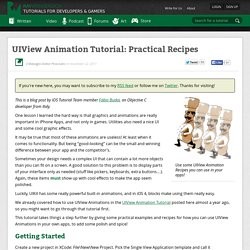
iPhone Development 101. Learn iOS SDK Development From Scratch - Tuts+ Code Tutorials. Video Tutorial: Objective-C Runtime. Creating a Simple QTKit Media Player Application. In this chapter, you build a QTKit media player application that takes advantage of some of the most useful methods and classes available in the QTKit framework.
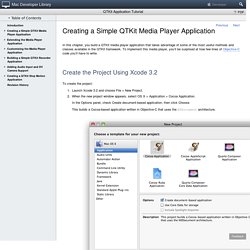
To implement this media player, you’ll be surprised at how few lines of Objective-C code you’ll have to write. Create the Project Using Xcode 3.2 To create the project: Launch Xcode 3.2 and choose File > New Project.When the new project window appears, select OS X > Application > Cocoa Application. In the Options panel, check Create document-based application, then click Choose. In the DocumentType row, select Binary from the Store Type and Viewer from the Role pull-down menu.
AVSimplePlayer. Using the YouTube Helper Library to embed YouTube videos in your iOS application - YouTube. How To Make a Custom Control - Ray Wenderlich. Learn how to make a custom control like a slider that has two knobs Update 8/27/14: Post now updated to iOS 8 and Swift, check it out!
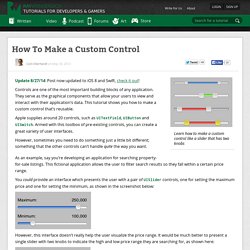
Controls are one of the most important building blocks of any application. They serve as the graphical components that allow your users to view and interact with their application’s data. This tutorial shows you how to make a custom control that’s reusable. Apple supplies around 20 controls, such as UITextField, UIButton and UISwitch. However, sometimes you need to do something just a little bit different; something that the other controls can’t handle quite the way you want. As an example, say you’re developing an application for searching property-for-sale listings. You could provide an interface which presents the user with a pair of UISlider controls, one for setting the maximum price and one for setting the minimum, as shown in the screenshot below: However, this interface doesn’t really help the user visualize the price range.
Anyhow, enough theory.